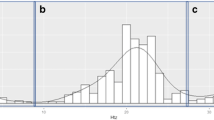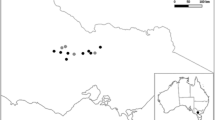Abstract
In species with duplicated major histocompatibility complex (MHC) genes, estimates of genetic variation often rely on multilocus measures of diversity. It is possible that such measures might not always detect more detailed patterns of selection at individual loci. Here, we describe a method that allows us to investigate classical MHC diversity in red jungle fowl (Gallus gallus), the wild ancestor of the domestic chicken, using a single locus approach. This is possible due to the well-characterised gene organisation of the ‘minimal essential’ MHC (BF/BL region) of the domestic chicken, which comprises two differentially expressed duplicated class I (BF) and two class II B (BLB) genes. Using a combination of reference strand-mediated conformation analysis, cloning and sequencing, we identify nine BF and ten BLB alleles in a captive population of jungle fowl. We show that six BF and five BLB alleles are from the more highly expressed locus of each gene, BF2 and BLB2, respectively. An excess of non-synonymous substitutions across the jungle fowl BF/BL region suggests that diversifying selection has acted on this population. Importantly, single locus screening reveals that the strength of selection is greatest on the highly expressed BF2 locus. This is the first time that a population of red jungle fowl has been typed at the MHC region, laying the basis for further research into the underlying processes acting to maintain MHC diversity in this and other species.





Similar content being viewed by others
References
Addie DD, Kennedy LJ, Ryvar R, Willoughby K, Gaskell RM, Ollier WER, Nart P, Radford AD (2004) Feline leucocyte antigen class II polymorphism and susceptibility to feline infectious peritonitis. J Fel Med Surg 6:59–62
Angles J, Kennedy L, Pedersen N (2005) Frequency and distribution of alleles of canine MHC-II DLA-DQB1, DLA-DQA1 and DLA-DRB1 in 25 representative American Kennel Club breeds. Tissue Antigens 66:173–184
Argüello J, Little A, Pay AL et al (1998) Mutation detection and typing of polymorphic loci through double-strand conformation analysis. Nat Genet 18:192–194
Bacon LD (1987) Influence of the major histocompatability complex on disease resistance and productivity. Poultry Sci 66(5):802–811
Bacon LD, Witter RL, Crittenden LB, Fadly A, Motta J (1981) B-haplotype influence on Marek's disease, Rous sarcoma, and lymphoid leukosis virus-induced tumors in chickens. Poultry Sci 60:1132–1139
Bakker PIW, McVean G, Sabeti PC et al (2006) A high-resolution HLA and SNP haplotype map for disease association studies in the extended human MHC. Nat Genet 38:1166–1172
Briles WE, Bumstead N, Ewert DL et al (1982) Nomenclature for chicken major histocompatibility (B) complex. Immunogenetics 15:441–447
Briles WE, Briles RW, Taffs RE, Stone HA (1983) Resistance to a malignant-lymphoma in chickens is mapped to subregion of major histocompatibility (B) complex. Science 219:977–979
Brown JH, Jardetzky TS, Gorga JC et al (1993) Three-dimensional structure of the human class II histocompatibility antigen HLA-DR1. Nature 364:33–39
Collins WM, Briles WE, Zsigray RM et al (1977) B locus (MHC) in chicken—association with fate of RSV-induced tumors. Immunogenetics 5:333–343
Edwards SV, Wakeland EK, Potts WK (1995) Contrasting histories of avian and mammalian MHC genes revealed by class II B sequences from songbirds. Proc Natl Acad Sci U S A 92:12200–12204
Edwards SV, Hess CM, Gasper J, Garrigan D (1999) Toward an evolutionary genomics of the avian MHC. Immunol Rev 167:119–132
Ewens WJ (1972) Sampling theory of selectively neutral alleles. Theor Popul Biol 3:87
Figueroa F, Gunther E, Klein J (1988) MHC polymorphism predating speciation. Nature 335:265–267
Fulton JE, Juul-Madsen HR, Ashwell CM, McCarron AM, Arthur JA, O'Sullivan NP, Taylor RL Jr (2006) Molecular genotype identification of the Gallus gallus major histocompatibility complex. Immunogenetics 58:407–21
Goto R, Afanassieff M, Ha J et al (2002) Single-strand conformation polymorphism (SSCP) assays for major histocompatibility complex B genotyping in chickens. Poultry Sci 81:1832–1841
Guillemot F, Billault A, Pourquie O et al (1988) A molecular map of the chicken major histocompatibility complex: the class II b genes are closely linked to the class I genes and the nucleolar organiser. EMBO J 7:2775–2785
Hala K, Vilhelmova M, Schulmannova J, Plachy J (1979) A new recombinant allele in the B-complex of the chicken. Folia Biologica (Praha) 25:323–324
Hala K, Chausse A, Bourlet Y et al (1988) Attempt to detect recombination between B-F and B-L genes within the chicken B complex by serological typing, in vitro MLR, and RFLP analyses. Immunogenetics 28:433–438
Hall TA (1999) BioEdit: a user-friendly biological sequence alignment editor and analysis program for Windows 95/98/NT. Nucl Acids Symp Ser 41:95–98
Hansson B, Richardson D (2005) Genetic variation in two endangered Acrocephalus species compared to a widespread congener: estimates based on functional and random loci. Anim Conserv 8:83–90
Hunt HD, Fulton JE (1998) Analysis of polymorphisms in the major expressed class I locus (B-FIV) of the chicken. Immunogenetics 47:456–467
Jacob JP, Milne S, Beck S, Kaufman J (2000) The major and minor class II b-chain (B-LB) gene flank the Tapasin gene in the B-F/B-L region of the chicken major histocompatibility complex. Immunogenetics 51:138–147
Jarvi SI, Tarr CL, McIntosh CE, Atkinson CT, Fleischer RC (2004) Natural selection of the major histocompatibility complex (MHC) in Hawaiian honeycreepers (Drepanidinae). Mol Ecol 13:2157–2168
Joiner KS, Hoerr FJ et al (2005) The avian major histocompatibility complex influences bacterial skeletal disease in broiler breeder chickens. Vet Pathol 42(3):275–281
Juul-Madsen HR, Dalgaard TS, Afanassieff M (2000) Molecular characterisation of major and minor MHC class I and II genes in B21-like haplotypes in chickens. Anim Genet 31:252–261
Kaufman J, Andersen R, Avila D et al (1992) Different features of the MHC class I heterodimer have evolved at different rates. J Immunol 148:1532–1546
Kaufman J, Volk H, Wallny H-J (1995) A ‘minimal essential MHC’ and an ‘unrecognised MHC’: two extremes in selection for polymorphism. Immunol Rev 143:63–88
Kaufman J, Jacob J, Shaw I et al (1999a) Gene organisation determines evolution of function in the chicken MHC. Immunol Rev 167:101–117
Kaufman J, Milne S, Gobel TWF et al (1999b) The chicken B locus is a minimal essential major histocompatibility complex. Nature 401:923–925
Kennedy LJ, Ryvar R, Gaskell RM et al (2002) Sequence analysis of MHC DRB alleles in domestic cats from the United Kingdom. Immunogenetics 54:348–352
Koch C, Skjødt K, Toivanen A, Toivanen P (1983) New recombinants within the MHC (B-complex) of the chicken. Tissue Antigens 21:129–137
Kumar S, Tamura K, Jakobsen IB, Nei M (2001) Mega 2: molecular evolutionary genetics analysis software. Bioinformatics 17:1244–1245
Kurtz J, Kalbe M, Aeschlimann PB et al (2004) Major histocompatibility complex diversity influences parasite resistance and innate immunity in sticklebacks. Proc R Soc Lond B Biol Sci 271:197–204
Lima-Rosa CAV, Canal CW, Streck AF et al (2004) B-F DNA sequence variability in Brazilian (blue-egg Caipira) chickens. Anim Genet 35:278–284
Liu YP, Wu GS, Yao YG et al (2006) Multiple maternal origins of chickens: out of the Asian jungles. Mol Phylogenet Evol 38:12–19
Livant EJ, Ewald SJ (2005) High-resolution typing for chicken BF2 (MHC class I) alleles by automated sequencing. Anim Genet 36:432–4
Livant EJ, Brigati JR, Ewald SJ (2004) Diversity and locus specificity of chicken MHC B class I sequences. Anim Genet 35:18–27
Miller MM, Bacon LD, Hala K et al (2004) 2004 nomenclature for the chicken major histocompatibility (B and Y) complex. Immunogenetics 56:261–279
Nei M, Gojobori T (1986) Simple methods for estimating the numbers of synonymous and nonsynonymous nucleotide substitutions. Mol Biol Evol 3(5):418–426
Nishibori M, Shimogiri T, Hayashi T, Yasue H (2005) Molecular evidence for hybridisation of species in the genus Gallus except for Gallus varius. Anim Genet 36:367–375
Ramon DS, Argüello JR, Cox ST et al (1998) Application of RSCA for typing of HLA-DPB1. Hum Immunol 59:734–747
Richardson DS, Westerdahl H (2003) MHC diversity in two Acrocephalus species: the outbred great reed warbler and the inbred Seychelles warbler. Mol Ecol 12:3523–3529
Richardson DS, Komdeur J, Burke T, von Schantz T (2005) MHC-based patterns of social and extra-pair mate choice in the Seychelles warbler. Proc R Soc Lond B Biol Sci 272:759–767
Rozas J, Sanchez-DelBarrio JC, Messeguer X, Rozas R (2003) DnaSP, DNA polymorphism analyses by the coalescent and other methods. Bioinformatics 19:2496–2497
Schierman LW, Watanabe DH, McBride RA (1977) Genetic control of Rous sarcoma regression in chickens: linkage with the major histocompatibility complex. Immunogenetics 5:325–332
Schütz KE, Jensen P (2001) Effects of resource allocation on behavioural strategies: a comparison of red jungle fowl (Gallus gallus) and two domesticated breeds of poultry. Ethology 107:753–765
Shaw I, Powell TA, Marston DA et al (2007) Different evolutionary histories of the two classical class I gene BF1 and BF2 illustrate drift and selection within the stable MHC haplotypes of chickens. J Immunol 178:5744–5752
Shiina T, Hosomichi K, Hanzawa K (2006) Comparative genomics of the poultry major histocompatibility complex. Anim Sci J 77:151–162
Shiina T, Briles WE, Goto RM et al (2007) Extended gene map reveals tripartite motif, C-type lectin and Ig superfamily type genes within a subregion of the chicken MHC-B affecting infectious disease. J Immunol 178:7162–7172
Single RM, Martin MP, Gao XJ et al (2007) Global diversity and evidence for coevolution of KIR and HLA. Nat Genet 39:1114–1119
Skjødt K, Koch C, Crone M, Simonsen M (1985) Analysis of chickens for recombination with the MHC (B complex). Tissue Antigens 25:278–282
Sunnocks P, Hales DF (1996) Numerous transposed sequences of mitochondrial cytochrome oxidase I–II in aphids of the genus Sitobion (Hemiptera: Aphididae). Mol Biol Evol 13:510–524
Tajima F (1989) Statistical method for testing the neutral mutation hypothesis by DNA polymorphism. Genetics 123:585–595
Takahata N (1990) A simple genealogical structure of strongly balanced allelic lines and transspecies evolution of polymorphism. Proc Natl Acad Sci U S A 87:2419–2423
Takahata N, Nei M (1990) Allelic genealogy under overdominant and frequency-dependent selection and polymorphism of major histocompatibility complex loci. Genetics 124:967–978
Tong JC, Bramson J, Kanduc D et al (2006) Modelling the bound conformation of Pemphigus vulgaris associated peptides to MHC class II DR and DQ alleles. Immunome Res 2:1
Vilà W, Seddon JM, Ellegren H (2005) Genes of domestic mammals augmented by backcrossing with wild ancestors. Trends Genet 21:214–218
Wallny H-J, Avila D, Hunt LG et al (2006) Peptide motifs of the single dominantly expressed class I molecule explain the striking MHC-determined response to Rous sarcoma virus in chickens. Proc Natl Acad Sci U S A 103:1434–1439
Watterson GA (1978) The homozygosity test of neutrality. Genetics 88:405–417
Westerdahl H, Waldenstrom J, Hansson B et al (2005) Associations between malaria and MHC genes in a migratory songbird. Proc R Soc Lond B Biol Sci 272:1511–1518
Worley K, Carey J, Veitch A, Coltman DW (2006) Detecting the signature of selection on immune genes in highly structured populations of wild sheep (Ovis dalli). Mol Ecol 15:623–637
Zelano B, Edwards SV (2002) An MHC component to kin recognition and mate choice in birds: Predictions, progress, and prospects. Am Nat 160:S225–S237
Zorn AM, Krieg PA (1991) PCR analysis of alternative splicing pathways: identification of artifacts generated by heteroduplex formation. Biotechniques 11:180–184
Acknowledgements
This work was supported by a Natural Environment Research Council grant to TP and DSR. All polymerase chain reaction amplifications, cloning and sequencing was carried out at the University of East Anglia while the running of the reference strand-mediated conformation analysis procedure was done with LJK at the University of Manchester.
Author information
Authors and Affiliations
Corresponding author
Rights and permissions
About this article
Cite this article
Worley, K., Gillingham, M., Jensen, P. et al. Single locus typing of MHC class I and class II B loci in a population of red jungle fowl. Immunogenetics 60, 233–247 (2008). https://doi.org/10.1007/s00251-008-0288-0
Received:
Accepted:
Published:
Issue Date:
DOI: https://doi.org/10.1007/s00251-008-0288-0




